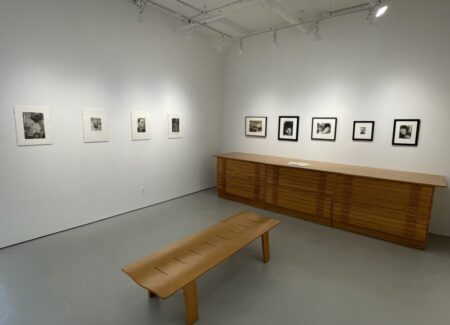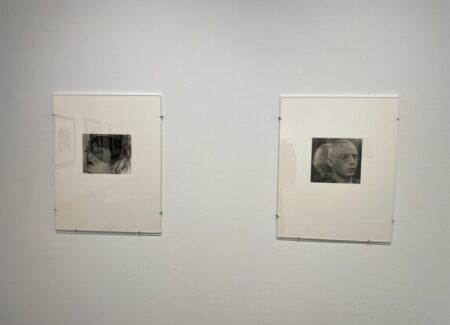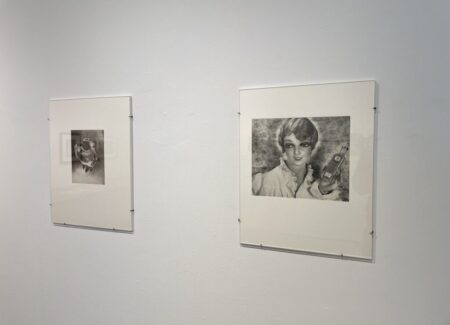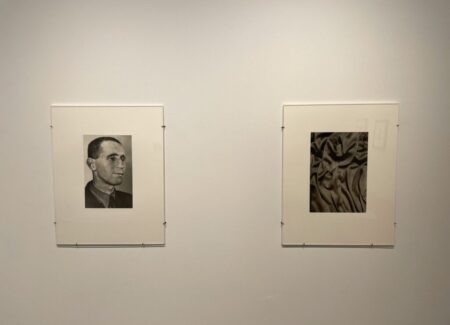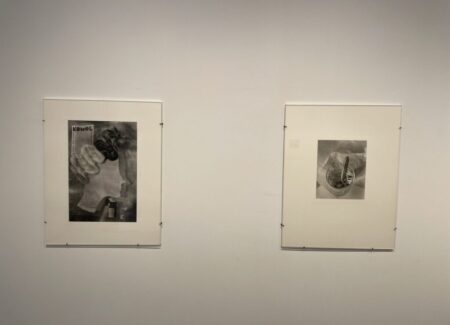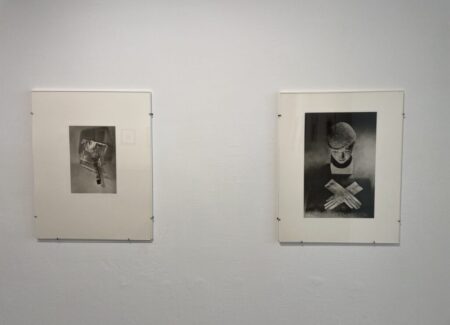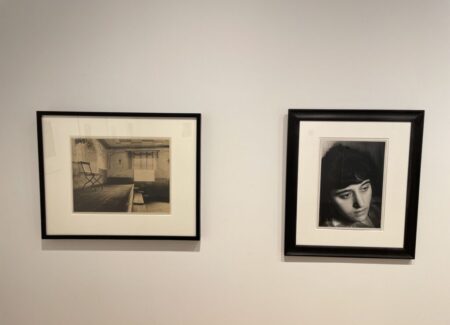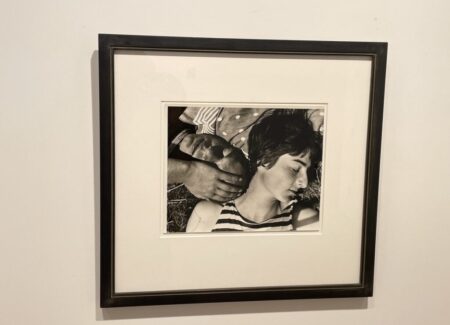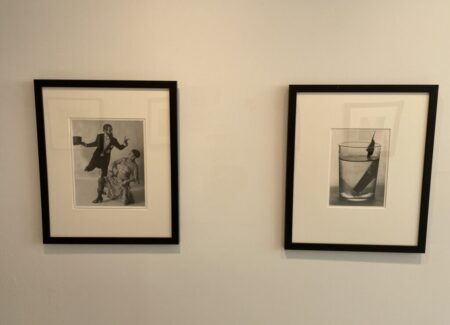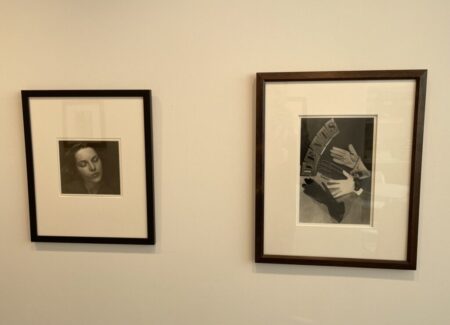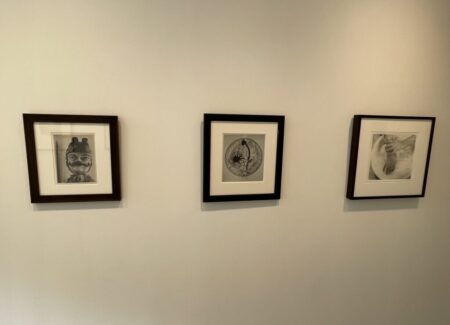JTF (just the facts): A total of 26 black-and-white photographs, either framed in black and matted or unframed, and hung against white walls in the main gallery space. (Installation shots below.)
The following works are included in the show:
- 6 gelatin silver prints (vintage/early), 1930, c1930, 1931, 1932, sized roughly 5×4, 6×5, 7×6, 10×8, 10×13, 12×9 inches
- 8 gelatin silver prints (lifetime), 1929, 1930, 1931, 1934, sized roughly 7×8, 8×8, 9×8, 9×10, 9×13, 10×7, 10×8, 12×8 inches
- 1 portfolio of 12 gelatin silver prints, 1929-1932/1985, individual prints sized roughly 6×4, 6×7, 7×6, 8×6, 8×7, 9×6, 10×9, 11×8, 13×9 inches
Comments/Context: The collaborative light of the artistic duo of Grete Stern and Ellen Auerbach, who professionally called themselves “ringl + pit”, burned brightly for a surprisingly brief period of time. The two German photographers were childhood friends (their nicknames forming the brand of their studio), and both studied privately under Walter Peterhans in Berlin in the late 1920s. When Peterhans took a job teaching at the Bauhaus in 1930, the two bought his equipment and set up shop on their own. They worked together for just a handful of years, through 1933 when the Nazis rose to power; over the following years, they both bounced around and ultimately emigrated – Stern to Argentina and Auerbach to the United States – putting an end to their innovative artistic partnership.
This show provides a succinct survey of the duo’s combined output, mixing a selection of vintage prints from the early 1930s with a full presentation of a portfolio of their ringl + pit work published by the gallery in 1985. Now almost a century later, the images still crackle with avant-garde experimentation and modern energy, jumping from advertising commissions and still life setups to more intimate self portraiture.
The pair’s advertising work is likely their most durably important and certainly their best known, mixing an eye for clarity in composition and graphic design with a playful edge of the surreal. Their Komol haircoloring ad from 1932 is an imaginative masterpiece, creating the abstracted impression of a face from paper silhouettes in light and dark, with a sweep of wavy hair (also in light and dark) laid atop a mesh sheet, with product samples and the company logo underneath. Their glove setup for Dents (from 1934) is similarly clever, with gloves intermingled with paper and wire hand forms all pointing the same direction, like a crowd reaching to shake hands, with the letters of the company name stacked in a shiny curve nearby. And their posed mannequin for Petrole Hahn hair conditioning (from 1931) initially seems straightforward, with the outdated blonde mannequin wearing a nightgown (apparently once owned by Auerbach’s mother) and holding the product, that is until we notice that the hand is actually human (not plastic like the head), making the whole setup feel charged with deliberate strangeness.
Even in seemingly simple single object still lifes, ringl + pit consistently found a way into any given subject that transformed it. They used the cellophane wrapper on a package of Güldenring cigarettes to create a distorted light and shadow study. They cropped a crumple of Maratti synthetic silk down into an elegant drapery exercise. And they turned a glove inside out, dropped dandelions in a glass of water, and tossed eggs on a tabletop, playing with sculptural qualities, see-through light contrasts, and formal mysteries, making the known seem just slightly unknown.
At that historical moment in Germany in the early 1930s, when more and more women were establishing themselves professionally and the independent “New Woman” was becoming more visible, ringl + pit were at the forefront of using their photography to subtly subvert traditional feminine stereotypes and roles and to celebrate a more modern feminine outlook. Not only did they use wigs and mannequins in their advertising setups as mannered stand-ins and facades for women, but their other images isolated prim hats and gloves with stifling bluntness, looked closely at the tying of a frilly corset, watched hands washing in a soapy basin, and looked on in a mirror as a woman applied lipstick, each composition pushing on definitions of how a woman should or could behave.
They applied these same kind of aesthetic approaches to the images they made of themselves, amplifying the confident modernity of their own looks and styles. Almost none of their self-portraits are composed in a conventional sense – several use steep angles or tight cropping, pulling us in close to pay attention to Stern’s bold glasses or Auerbach’s sideways look through an elaborately veiled and feathered hat. An image of Auerbach with her husband Walter relaxing in the grass is another knockout, looking straight down at their heads nestled together, flanked by various striped and polka dotted patterns; the composition feels carefully arranged, almost like a puzzle, with each piece (of color, texture, form, or humanity) placed to perfection. Still other portraits are innovative in other ways, from mirroring a smooth bald head to making a portrait of a woman with her eyes gently closed.
With the benefit of hindsight, we can now recognize just how groundbreaking Stern and Auerbach were in terms of starting their own studio and making images that unpacked feminine identity with such visual wit. They seem to have inhaled many of the aesthetic lessons and strategies of Modernism that would come to be identified with the Bauhaus, and then thoughtfully applied them to the modern lives they were leading. Their work as ringl + pit deserves to be better known, with reminder shows like this one bringing their photographs back into the conversation around feminist art making strategies throughout the past century.
Collector’s POV: The works in this show are priced as follows. The single image vintage and lifetime prints range in price from $7500 to $18000, while the portfolio of 12 prints (published in 1985) is available at $35000. Works by ringl + pit have only been intermittently available in the secondary markets in the past decade, with single images ranging from roughly $1000 to $10000, and full editions of the portfolio ranging from roughly $10000 to $17000.
